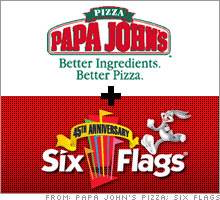Innovative partneringHow smart alliances lend a hand to help midmarket growth.(Business 2.0 Magazine) -- Modest growth might have been acceptable a few years ago in the wake of the dotcom crash, but in today's competitive climate, slow and steady just doesn't cut it. Midsize companies are squeezed between startups with buzz and stock options on one side and multinational behemoths on the other. How to turn up the throttle?
There's a reason "strategic collaboration" and "team building" are the catchphrases du jour. The smartest companies know it's usually unwise to go it alone. They also know who to team up with and how to forge strong relationships so everyone gets ahead. Read on for a guide to smart partnering, whether it's with your competition, your employees, or the wider community. After all, sharing is most satisfying when everyone makes money. Making strategic alliances pay off Self-sufficiency may be a prized trait in our culture, but being a lone ranger can be a big mistake for a midsize company, especially in an increasingly global economy. "We're finding that we have to be better at more things than we used to have to be," says Ed Rigsbee, a corporate consultant and author of PartnerShift and Developing Strategic Alliances. "But it's impossible to be good at everything, so the key is to look for partners with core competencies that fill in your gaps." Partner relationships can take many shapes, from simple supply-chain or distribution deals to complex joint ventures involving multiple parties. But the point is to join forces with someone whose skills or connections allow you to accomplish something bigger, faster, or better than you could on your own. As an example, Rigsbee cites the model of a buying group, in which a number of smaller distributors join together to better compete with the purchasing muscle of larger players. One mistake many businesses make is refusing to partner with the competition for fear that it'll steal secrets or gain an advantage. It's far better to follow the oft-quoted advice of Michael Corleone: Keep your friends close, but your enemies closer. After all, your competition is your competition because you share the same goals. So why not use that common ambition to your mutual benefit? You might even find that partnering can double your success. "Nowadays," Rigsbee says, "somebody might be my competitor in the morning, and by the afternoon we might be working together on something." Snapshot: Papa John's and Six Flags Marketing partnerships work best when two products go well together, which is certainly the case with pizza and amusement parks. Hence the multiyear strategic alliance between Papa John's pizza restaurants and Six Flags theme parks, announced last March. The partnership makes Papa John's the only pizza available within Six Flags properties, and helps Six Flags reach out to consumers at some 1,100 Papa John's restaurants located within a 100-mile radius of a Six Flags park. The alliance will certainly boost the stature of fast-growing Papa John's. The Kentucky-based company, which started in the back of an Indiana bar in 1984, operates 2,978 restaurants in 49 states and 25 countries. The deal includes a Web and e-mail campaign promoting Papa John's to Six Flags online customers and in-park distribution of Papa John's coupons. For its part, Six Flags, headquartered in New York City, receives an undisclosed annual sponsorship payment and the chance to advertise its parks on Papa John's pizza boxes. Next: The secret to strategic alliances that last _______________________ 4 ways to successful partnering:
Melanie Haiken is a San Rafael, Calif., writer and a frequent contributor to Business 2.0. |
|


